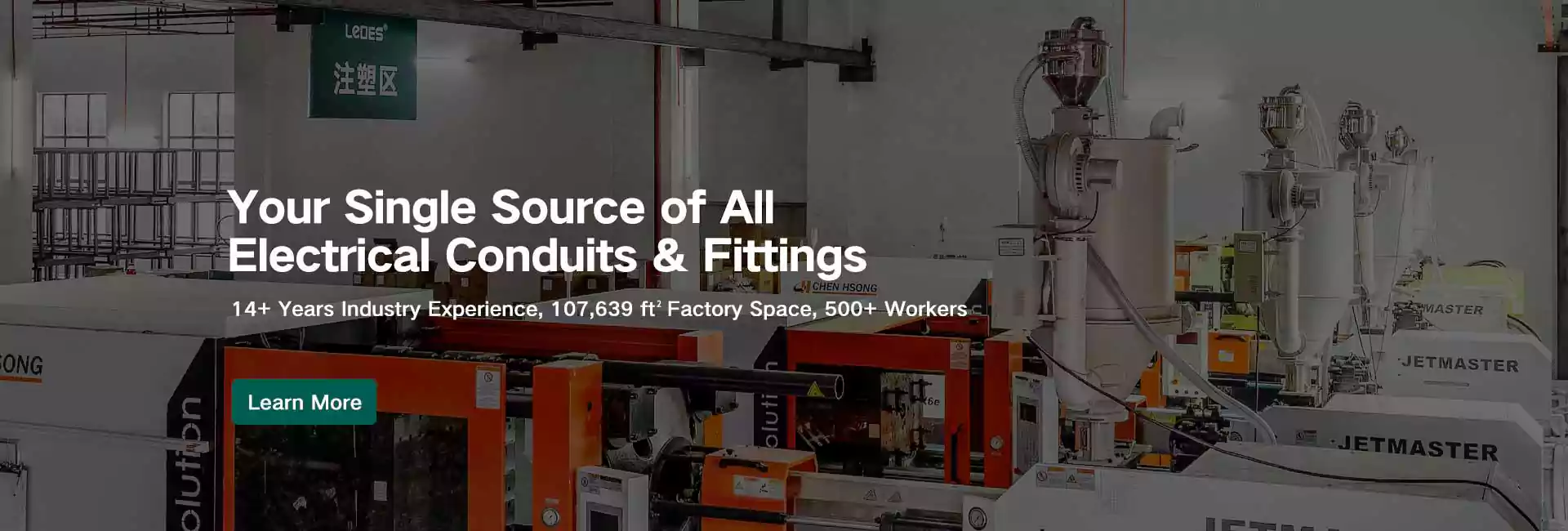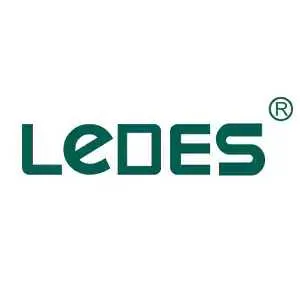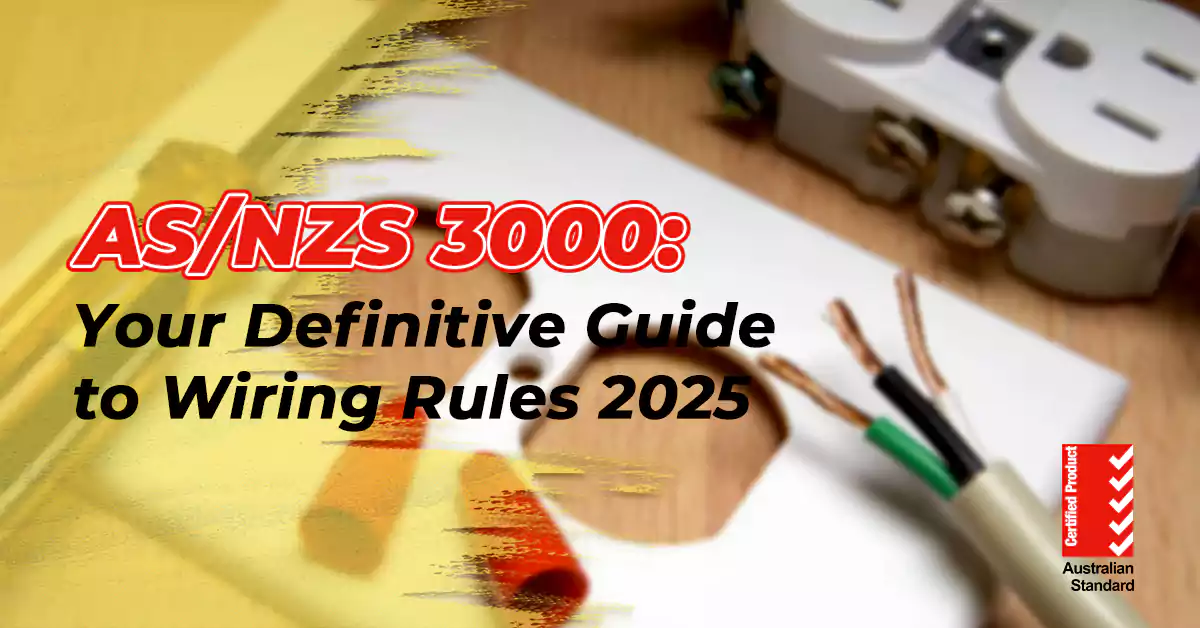
Inhaltsverzeichnis
Whether you’re an electrician, an electrical engineer, or a manufacturer of electrical related products like conduits and fittings, understanding the wiring standards and requirements is essential.
In Australia and New Zealand, the benchmark for electrical installations is the AS/NZS 3000:2018 Wiring Rules. This standard sets the foundation for electrical safety, reliability, and performance across residential, commercial, and industrial projects. From the layout of wiring systems to the selection of protective devices, AS/NZS 3000 defines how every part of an installation must be designed and executed.
As a PVC conduit supplier, we’ve seen firsthand how compliance with the Wiring Rules affects product selection, material performance, and installation methods. For example, choosing a UV-resistant rigid PVC conduit or ensuring mechanical protection in exposed areas directly ties into specific clauses within the standard. That’s why it’s critical not only for installers and inspectors to understand the code, but also for product manufacturers and suppliers like us.
The goal of this article is simple: to help you clearly understand what AS/NZS 3000 is, why it matters, and what you need to do to comply with safety requirements of electrical systems in Australia and New Zealand.
Profi-Tipps: Want to learn more about electrical codes in different countries? You can refer to our earlier posts, including the Expert Guide to NEC Code (for the United States) and the Ultimate Guide to CEC Code (for Canada).
What is AS/NZS 3000:2018?
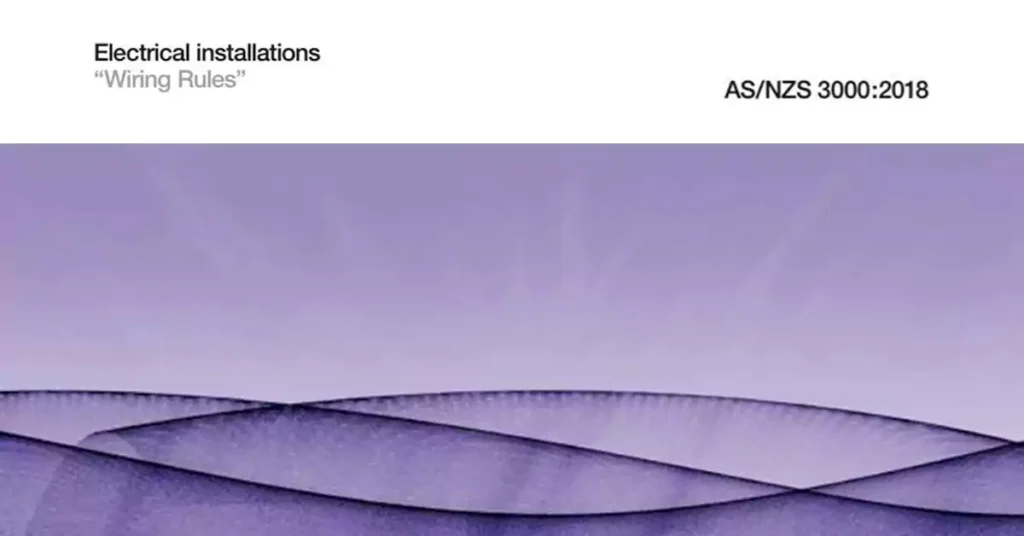
AS/NZS 3000:2018, officially titled “Electrical Installations – Known as the Australian/New Zealand Wiring Rules”, is the core electrical standard that outlines the minimum requirements for the design, construction, and verification of all electrical installations in Australia and New Zealand. It provides the foundation for safety, functionality, and compliance across residential, commercial, and industrial projects.
This standard ensures that installations are built to minimize risks such as electric shock, fire, and equipment failure. While electricians are its primary users, it also plays a critical role for engineers, inspectors, and manufacturers like us, particularly when we’re developing or supplying electrical products such as cables, conduits and fittings that must meet specific code requirements.
AS/NZS 3000:2018 is best known for setting the rules on how wiring systems must be designed and installed. While it covers much more than just electrical cable, it includes protective devices, enclosures, raceway systems, earthing, and installation techniques. It is the long-standing role in defining safe and compliant wiring practices.
Why It Matters for Electricians, Engineers, and Inspectors
AS/NZS 3000:2018 is not just a technical guideline, it’s a daily reference and legal requirement. For electricians, it ensures that installations meet safety standards. For engineers and consultants, it provides design clarity. For inspectors, it serves as the benchmark for evaluating installation quality.
The Role of Standards Australia and Standards New Zealand
Standards Australia and Standards New Zealand are the two independent national organizations responsible for the development of AS/NZS 3000:2018. While the standard itself is not legislation, it is mandated by electrical safety laws across all Australian states and territories, and New Zealand regulations, making compliance effectively compulsory.
This bi-national development ensures consistency across both countries while allowing local authorities to enforce it through regional licensing and inspection regimes.
Overview of AS/NZS 3000:2018
To ensure safe and compliant electrical installations, AS/NZS 3000:2018 is structured in a logical and practical way. It guides users from foundational safety principles all the way through to specific installation practices, testing, and verification. Understanding the overall structure is important, not just for electricians and engineers, but also for some users at home manufacturers of electrical products. This helps ensure that every material or product we provide supports compliance at every stage of an installation.
How the Standard is Structured
The standard is divided into two main parts:
Part 1: Scope, Application, and Fundamental Principles
This section sets out the overall objectives and core safety principles of the standard. It explains the types of installations covered, the responsibilities of practitioners, and the essential goals of electrical safety—such as preventing electric shock, fire, and mechanical damage. It also outlines fundamental design concepts to ensure systems are reliable, maintainable, and energy efficient.
Part 2: Installation Practices (Sections 2 to 8)
This section contains the technical rules and practical methods used to meet the requirements set out in Part 1. It covers topics such as wiring methods, protection against overcurrent and fault conditions, earthing, equipment installation, and specific requirements for special locations like bathrooms or hazardous areas. It also includes procedures for testing and verifying installations to confirm compliance before energization.
Together, these two parts provide a complete guide for achieving electrical safety and regulatory compliance, forming the backbone of modern electrical installation work in Australia and New Zealand.
Together, these sections form a complete set of rules that apply to all types of electrical installations, whether domestic, commercial, industrial, or infrastructure-based.
Key Sections of AS/NZS 3000 You Should Know
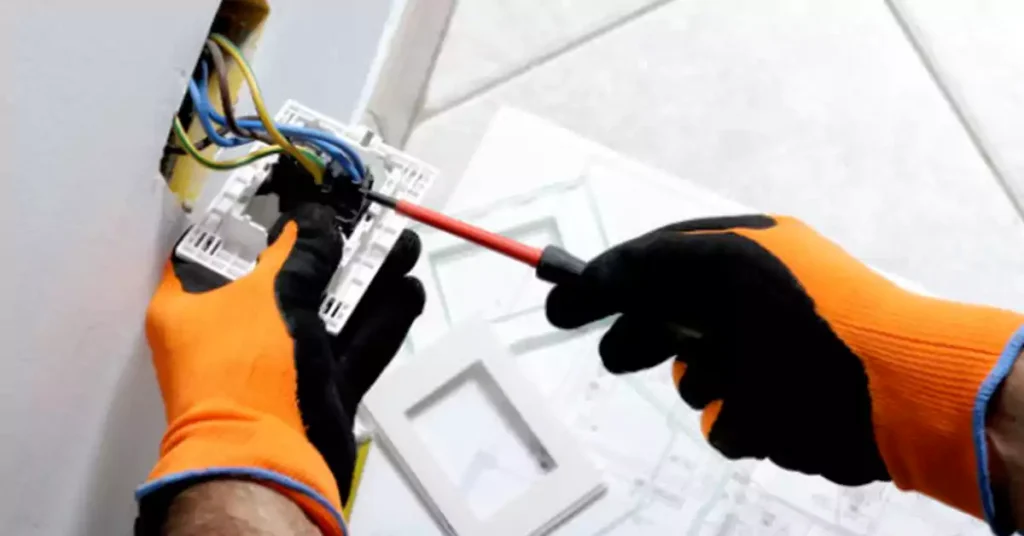
Understanding Part 1: Fundamental Safety Principles
Part 1 of the AS/NZS 3000:2018 standard sets out the fundamental principles for achieving safe and functional electrical installations. It outlines baseline safety objectives to protect people, property, and livestock from hazards associated with electrical systems during regular use or under fault conditions. These core requirements underpin the design, installation, and verification of all electrical installations covered by the standard.
Protection Against Common Electrical Risks
The standard identifies three primary risks in electrical installations and provides guidance to mitigate each:
Electric Shock (Shock Current):
Protection is required against both direct contact (normal live parts) and indirect contact (parts that become live under fault conditions). This includes:
Basic protection: Preventing access to live parts through insulation, barriers, or placing components out of reach.
Fault protection: Preventing exposed conductive parts from becoming live under fault conditions through proper earthing and disconnection methods.
Verbesserter Schutz: Systems such as SELV (Separated Extra-Low Voltage) or PELV (Protected Extra-Low Voltage) can provide both types of protection under specified conditions.
Excessive Temperatures and Fire Hazards:
Installations must prevent burns, equipment damage, or material ignition due to heat from electrical equipment. Measures include proper thermal management, spacing, and the use of non-combustible materials near hot components.
Explosive Atmospheres:
In areas with flammable gases or dust, the equipment must be designed to prevent ignition sources, ensuring compatibility with hazardous environments.
Additional Core Protective Measures
Protection Against Overcurrent:
Overcurrent caused by overload or short circuit can lead to fire or damage. The standard requires automatic disconnection or current limitation to keep temperatures and mechanical stress within safe limits.
Protection Against Earth Fault Currents:
Earth fault currents must be safely carried away by protective conductors sized to withstand the expected current without overheating.
Protection Against Fire Spread:
Electrical components must not initiate or propagate fire. This includes using flame-retardant materials and minimizing arc generation during operation.
Resistance to External Influences:
Installations must be suited to their environment, resisting damage from moisture, temperature, mechanical impact, and other external conditions expected during normal use.
Design and Equipment Selection Principles
The standard mandates that all installations must:
Ensure safety and prevent harm under all foreseeable conditions.
Perform their intended functions without compromising reliability.
Be compatible with the connected power supply and grid characteristics.
Allow safe inspection, testing, and maintenance procedures.
All electrical equipment used must be:
Selected and installed to prevent hazards during both normal and abnormal conditions.
Installed in line with both the standard and the manufacturer’s specifications.
Verification and Ongoing Compliance
Before any new installation or modification is put into service, it must undergo thorough inspection and testing to verify compliance with the standard. In Australia, full compliance with Part 2 is deemed to satisfy Part 1. Additionally, installations may comply with other referenced standards as outlined in the relevant sections of the document.
Part 2: Installation Practices
Section 2: General Arrangement, Control, and Protection
Section 2 of Part 2 in AS/NZS 3000:2018 sets out the minimum requirements for the selection, installation, control, and protection of switchgear and control gear within an electrical installation. This section is fundamental to ensuring safety, operational reliability, maintainability, and compliance with the broader objectives defined in Part 1 of the standard.
General Requirements for Control and Protection Equipment
This section applies to the proper selection and installation of switchgear and control gear, which serve as critical elements in controlling, isolating, and protecting electrical installations. These components must support safe operation during maintenance, fault detection, or emergency shutdowns.
Selection and Installation Criteria
Switchgear and control gear must be selected and installed to:
- Enable control and isolation of circuits, apparatus, or the entire installation to allow safe maintenance and testing.
- Automatically disconnect supply in the event of overloads, short circuits, or excessive earth leakage currents.
- Provide overvoltage and undervoltage protection to safeguard both equipment and users.
- Be grouped logically on switchboards, with enclosures offering appropriate protection from external environmental conditions, and positioned for easy access.
- Independently control and protect circuit arrangements, ensuring that a fault in one section does not compromise the operation of others.
- Comply with both this standard and manufacturer specifications to ensure functional and safety integrity.
Arrangement of the Electrical Installation
Electrical installations must be divided into a suitable number of separate circuits, based on:
- Functional grouping of equipment, including any user-defined needs or grouped operations.
Load characteristics and operating demands, which influence the rating of cables, protective devices, and other components.
- Fault tolerance, limiting the consequences of a failure in one circuit on the rest of the system.
- Provision for maintenance, modifications, and future expansion without interrupting power supply to critical areas.
- Safety services, such as emergency lighting or fire alarms, must have circuits that are completely separate from general electrical supply circuits。
Fault Protection
AS/NZS 3000 recognizes three main methods of fault protection:
Automatic disconnection of supply
Use of Class II equipment or equivalent insulation
Electrical separation
Automatic Disconnection of Supply
The most common method involves:
Earthing systems that connect exposed conductive parts to a protective earthing conductor.
Protective devices such as circuit breakers or residual current devices (RCDs) that disconnect power when a fault occurs, thereby limiting hazardous touch voltages.
Überstromschutz
General
Active conductors must be protected against overcurrent to prevent overheating, fire, or mechanical damage. Protection must cover both:
Overload currents (caused by excessive load over time)
Short-circuit currents (caused by fault conditions)
Protection devices must:
Disconnect supply rapidly before damage or injury occurs
Avoid use of fuses in neutral conductors, except where specifically permitted
Be coordinated to ensure correct operation in different fault scenarios
Note: Overcurrent protection must account for installation methods, cable sizes, and thermal effects. Appendix I of the standard offers guidance for existing imperial-sized conductors.
Over voltage Protection
Over voltages can be caused by lightning strikes, insulation faults, switching surges, or resonance. Where such conditions present a hazard to people or property, suitable surge protective devices (SPDs) must be installed.
Special consideration should be given to:
- Geographic regions with frequent lightning activity
- Installations sensitive to transient voltages
Undervoltage Protection
Undervoltage protection is required where voltage drops or restoration of power could:
- Cause hazardous restarts (e.g., industrial equipment like presses or gates)
- Result in equipment damage or failure to operate safely
Common causes of undervoltage include overload conditions, supply faults, or high impedance connections. Where the risk is acceptable, undervoltage protection may be omitted.
Arc Fault Protection
Arc faults, which can result in fire hazards, particularly in sleeping accommodations, wooden buildings, or locations with flammable materials, may be mitigated through the use of Arc Fault Detection Devices (AFDDs).
AFDDs:
- Detect and disconnect power when arcing is detected.
- Are recommended for enhanced fire safety, especially in high-risk environments.
Section 3: Selection and Installation of Wiring Systems
Section 3 of AS/NZS 3000:2018 sets out the minimum requirements for the selection and installation of wiring systems to ensure electrical safety, performance, and compliance with the fundamental safety principles established in Part 1 of the Standard.
General Requirements of Section 3
This section begins by establishing that all wiring systems must be chosen and installed to protect users and property, considering both mechanical and environmental conditions. Key functional requirements include:
- Protection from contact with live parts, using insulation or physical barriers.
- Compliance with current-carrying capacity and voltage drop limits.
- Reliable connections, joints, and terminations to ensure electrical continuity.
- Appropriate mechanical support and fixing methods.
- Suitability for specific conditions, such as fire-resistance or hazardous environments.
- Durability against mechanical damage and environmental influences.
- Installation in accordance with manufacturer’s instructions and the standard’s criteria.
Characteristics such as conductor material, core identification, insulation performance, temperature rise, and allowable bending or tension must also be considered.
External Influences
The installation environment plays a critical role in wiring system selection. Factors such as ambient temperature and hazardous area classification must be assessed. Notably:
- For cables installed in air, the reference ambient temperature is 40°C in Australia and 30°C in New Zealand.
- For buried cables or underground enclosures, the reference temperatures are 25°C (Australia) and 15°C (New Zealand).
- Additional provisions apply to hazardous areas, as outlined in Clause 7.7.
Current-Carrying Capacity
Conductors must have adequate current-carrying capacity per the AS/NZS 3008.1 series. This includes allowances for foreseeable environmental changes, like future thermal insulation, which may affect heat dissipation in domestic settings.
Voltage Drop
Voltage levels at equipment terminals must remain within safe operating limits. The maximum allowable voltage drop in any low-voltage installation is 5% of the nominal voltage at the supply point.
Electrical Connections
All electrical connections must ensure electrical continuity, mechanical integrity, and sufficient insulation. Cables should be joined using appropriate methods and installed without imposing mechanical stress on terminations.
Installation Requirements
Installations must follow sound engineering practices to resist mechanical or electrical failure. Key highlights include:
- Installation methods must match environmental conditions and follow manufacturer guidance (Table 3.1).
- Support and fixing should prevent stress or damage and maintain compliance with building codes.
- Protection against mechanical damage is required where impact or wear is likely.
- Segregation of voltage levels must prevent interaction between circuits of differing voltages unless specific insulation or barriers are used.
- Fire mitigation must be addressed through materials selection and design to prevent the spread of flames or combustion products.
- Electromagnetic interference (EMI) should be minimized where sensitive equipment is involved, using suitable cables, enclosures, or configurations.
Underground Wiring Systems
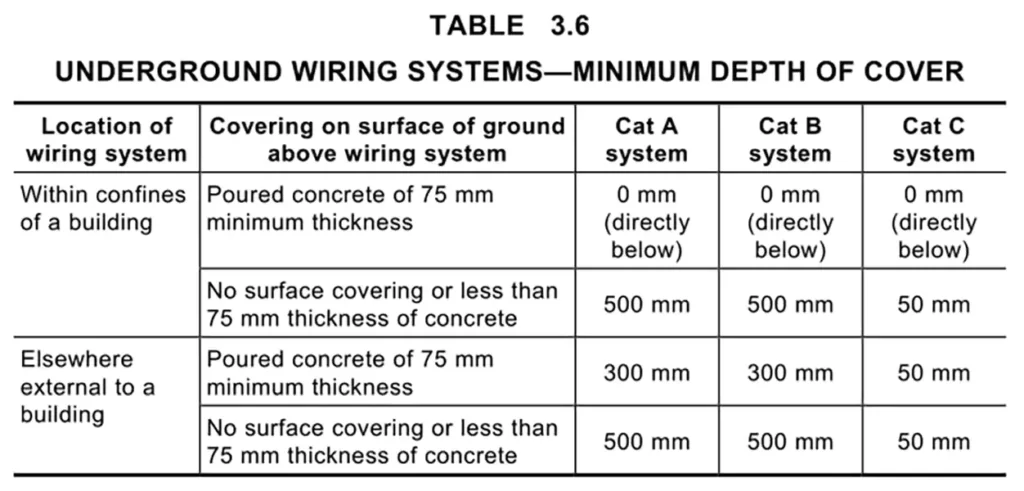
Wiring systems installed underground must be:
Appropriate for the environment, and
Protected from accidental damage, such as by excavation.
Cables must include warning indicators and meet minimum cover depths as defined in Table 3.6. Underground systems are classified as:
Category A – Inherently suitable without additional protection.
Category B – Require added mechanical protection.
Category C – Installed in rock channels.
Hinweise: Want to learn more about the Underground Wiring Systems? This article explains in detail the purpose, benefits, and installation of Concealed Conduit Wiring.
Section 5: Earthing Arrangements and Conductors
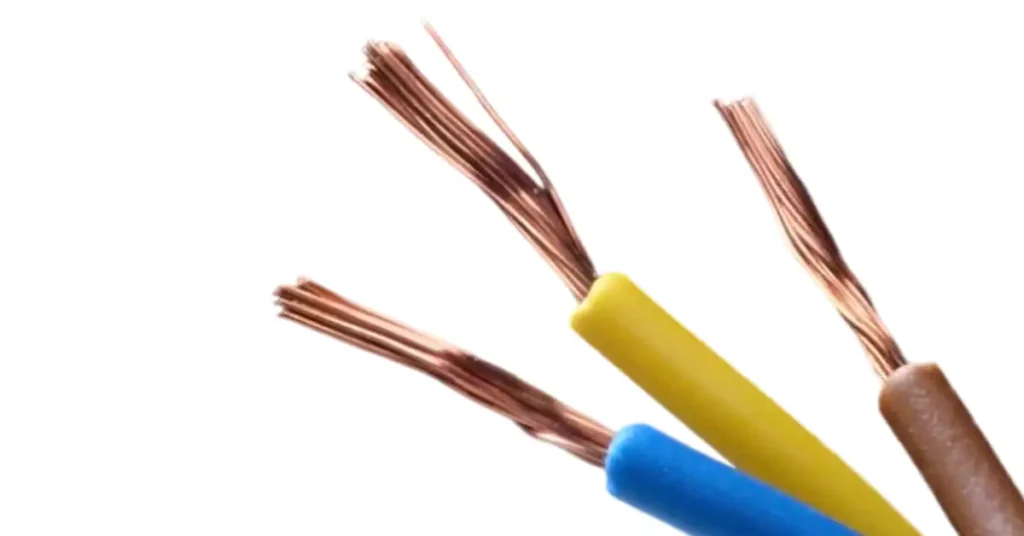
Section 5 outlines the minimum requirements for the selection and installation of earthing systems and conductors, as required to comply with the fundamental safety provisions of AS/NZS 3000 Part 1. These requirements apply to all types of electrical installations and are essential for ensuring safe operation, fault protection, and mitigation of electric shock risk.
Selection and Installation
Earthing arrangements must be carefully selected and installed to fulfill several critical functions:
- Automatic disconnection of supply in case of a fault to earth or excessive earth leakage current.
- Support of functional earth (FE) systems for equipment requiring a stable earth reference for operation.
- Mitigation of voltage differences between exposed conductive parts and extraneous conductive parts through effective equipotential bonding.
- Provision of a reliable low-impedance fault path capable of safely conducting fault and leakage currents under various physical and environmental conditions.
- Enable secure connections for both exposed and extraneous conductive parts.
MEN Earthing System
The standard is primarily based on the Multiple Earthed Neutral (MEN) system, the default earthing method in Australia and New Zealand. In this arrangement:
- The neutral conductor (PEN) is earthed at the supply source, at regular points across the distribution network, and again at each electrical installation.
- Within the installation, the earthing system is kept separate from the neutral conductor, ensuring proper connection of all exposed conductive parts to a dedicated earth reference.
Other Earthing Systems
Alternative earthing systems may be acceptable provided they meet the fundamental safety outcomes of Part 1 and do not adversely affect the characteristics of the supplying distribution system.
Earthing Functions
Protective Earthing ensures that if a fault occurs, touch voltages are minimized and the supply is disconnected quickly to avoid harm.
Functional Earthing (FE) is used to help certain equipment operate correctly, not necessarily for safety. For example, some electronics or data systems need a ‘clean’ earth.
If protective and functional earthing are combined, the protective requirements always take priority.
Components of the Earthing System
A complete earthing system typically includes:
Protective earthing conductors to connect exposed conductive parts.
The main earthing conductor, linking the system to earth.
The main earthing terminal or bar (a central connection point).
A link (MEN connection) between the main earthing bar and the neutral.
An earth electrode buried in the ground.
Equipotential bonding to connect other metal parts and reduce voltage differences.
Conductor Materials and Types
Copper is the most common material, and must be high-conductivity copper in stranded, braided, or solid form.
Aluminium may also be used, but with limitations such as minimum sizes and restrictions on damp or underground use.
Other materials can be used if they perform at least as well in conductivity and corrosion resistance as copper.
Earthing Conductor Sizing
Earthing conductors must be large enough to:
Carry fault current safely without overheating.
Keep earth loop impedance low enough to trip protection devices.
Withstand mechanical and environmental stress.
Earthing of Equipment
All exposed metal parts of electrical equipment that could become live during a fault must be earthed unless they are:
Double insulated and marked as such.
Supplied by SELV or PELV systems (low voltage, safe by design).
Electrically separated from earth in a compliant way.
Main Earthing Conductor
This conductor connects the main earthing bar in the switchboard to the earth electrode. It must be run as directly as possible and not be connected directly to any appliance or accessory terminal.
Equipotential Bonding
Equipotential bonding connects conductive parts (like water pipes or metal frames) to the earthing system to reduce the risk of electric shock. This helps equalize potential differences that could arise due to:
External faults (like faults on incoming water or gas pipes).
Earth currents from the power system.
Lightning strikes or nearby voltage surges.
Section 7: Special Electrical Installations
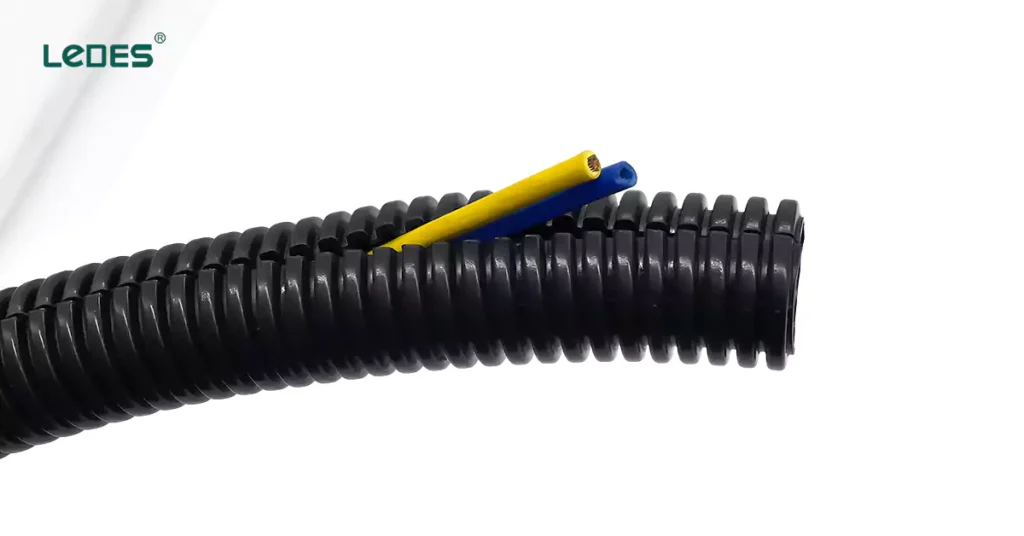
Section 7 of AS/NZS 3000:2018 provides specific requirements for the selection and installation of electrical equipment in special electrical installations. These installations are considered “special” due to their unique operational conditions, safety requirements, or risk environments. This section either supplements, replaces, or modifies the general installation requirements found in other parts of the Standard to ensure that safety and functional performance are maintained under these specific circumstances.
Safety Services
This clause deals with electrical systems essential for emergency and life safety, such as:
- Fire detection, warning, and extinguishing systems
- Smoke control and ventilation systems
- Emergency evacuation systems
- Lift systems used during emergencies
The primary goal is to ensure continuity of power during critical events. Specific requirements include robust wiring systems that can withstand fire and mechanical damage, as well as clear provisions for supply continuity, redundancy, and equipment classification under WS (Wiring System) ratings as outlined in AS/NZS 3013.
Electricity Generation Systems
Clause 7.3 covers various on-site power generation systems, including:
- Alternative and supplementary supply systems (e.g., standby generators)
- Stand-alone systems (not connected to the utility grid)
- Interactive inverter systems (connected systems using renewable energy sources like solar or wind)
- Battery systems
It sets minimum safety and performance standards to ensure safe operation during grid-connected and isolated operation. It also addresses energy flow control, voltage compatibility, load management, and the conditions for exporting power back to the grid.
Extra-Low Voltage Electrical Installations
Extra-low voltage (ELV) systems—such as SELV (Separated Extra-Low Voltage) and PELV (Protected Extra-Low Voltage)—are covered here. These systems are widely used in:
- Telecommunications
- Security systems
- Control circuits
The clause outlines criteria for voltage limitations, source isolation, circuit separation, overcurrent protection, and appropriate wiring practices to ensure safety from electric shock and fire risk. It also clarifies when ELV installations can be exempt from certain protections.
High Voltage Electrical Installations
High voltage installations (operating above 1000 V a.c. or 1500 V d.c.) demand specific safety and performance considerations. Clause 7.6 addresses:
- Required clearances, insulation levels, and earthing systems
- Access and fire protection measures
- Testing and labelling
- Design coordination with AS 2067 (Australia) and the Electricity (Safety) Regulations (New Zealand)
It ensures that high voltage systems, often used in industrial or utility-scale environments, are safely integrated into broader electrical installations.
Hazardous Areas
This clause outlines requirements for electrical equipment used in hazardous areas—places where flammable gases, vapours, or combustible dusts are present, such as:
- Oil refineries
- Chemical plants
- Grain silos
- Paint shops
It references AS/NZS 60079 series for classification, selection, and installation of explosion-protected electrical equipment. Proper area classification, equipment certification, and installation methods are critical to mitigate the risk of ignition and explosion.
Electric Vehicle Charging
As EV adoption accelerates, this section provides a comprehensive framework to ensure safe and standard-compliant infrastructure for both residential and commercial EV charging systems.
Section 7.9 supplements the general requirements in Sections 2 to 7 by addressing the specific safety, supply, and installation considerations for EV charging systems. Additional guidance is provided in:
Appendix P – on EV charging modes.
Appendix C – on how EV charging affects maximum demand calculations.
System of Supply
All EV charging systems must use a TN-C-S (MEN) earthing system. Importantly, they cannot be supplied via submains that use PEN conductors to outbuildings, due to earthing safety risks. This ensures proper operation of EV charging systems’ earthing failure detection mechanisms.
Residential Installations:
Mode 1 charging using general socket-outlets is not allowed.
Mode 2 chargers must use a dedicated 20 A circuit, a Type B RCD, and a compliant socket-outlet installed at least 800 mm above ground.
Mode 3 and 4 chargers (faster charging types) require a dedicated 32 A circuit, direct wiring, an isolating switch, and a Type B RCD for protection.
Non-Residential Installations:
All EV chargers must have Type B RCD protection, ensuring safety from DC and fault currents.
Profi-Tipps: Want to learn about the global electrical codes for electric vehicle charging? Check out our last expert guide to the 4 standards for charging electric vehicles for more information.
Appendix N – Electrical Conduits
Appendix N of AS/NZS 3000:2018 outlines essential guidance on electrical conduit systems used for cable management in Australian and New Zealand electrical installations. It details two parallel sets of standards that govern the design, performance, and marking of conduit products, ensuring compatibility with the region’s regulatory and environmental demands. These standards apply to a wide range of conduit types—including rigid, flexible, and corrugated systems—used in residential, commercial, industrial, and infrastructure applications.
Leitungstypen
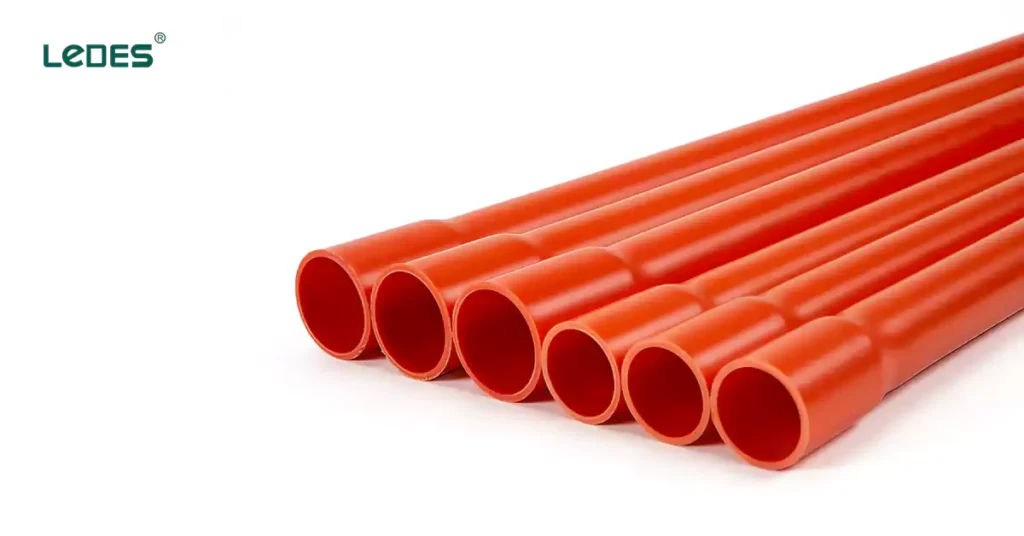
Rigid Conduits (AS/NZS 2053.2 / AS/NZS 61386.21)
Rigid conduits are hard-walled, straight tubes made typically from PVC or halogen-free thermoplastics. They are used for exposed or embedded wiring in fixed installations where mechanical protection is needed.
Common uses: Underground installations, wall recesses, industrial settings.
Flexible Conduits (AS/NZS 2053.4 / AS/NZS 61386.23)
Flexible conduits can bend easily without permanent deformation, ideal for short runs, dynamic installations, or areas requiring vibration resistance.
Common uses: Machine wiring, modular enclosures, connection to motors and HVAC.
Corrugated Conduits (AS/NZS 2053.5)
Corrugated conduits feature a ribbed, flexible design that allows bending without fittings. Often used in domestic and light commercial applications, they are easier to install in confined or curved spaces.
Common uses: Ceiling spaces, cable drops, switchboard wiring.
Profile Wall, Smooth Bore Conduits (AS/NZS 2053.6)
These conduits combine a structured external wall (for flexibility and strength) with a smooth internal bore, improving ease of cable pulling. They offer a balance between flexibility and high mechanical strength.
Common uses: Infrastructure, solar, data, and telecommunication installations.
Pliable Conduits (AS/NZS 61386.22)
Pliable conduits maintain a shape when bent, unlike flexible conduits which return to original shape. These are less common but used in specialist or custom routing applications.
Common uses: Control panels, customized wiring systems, vehicle or equipment cabling.
Understanding Duty Ratings
Conduits under both standards are classified into duty ratings based on their mechanical strength and environmental resistance. These ratings help specifiers choose the correct product for the intended application:
VLD – Very Light Duty: Low-risk areas, internal cabling
LD – Light Duty: General residential wiring
MD – Medium Duty: Commercial, ceiling/roof space
HD – Heavy Duty: Understand, exposed areas
VHD – Very Heavy Duty: Industrial, high-traffic zones
Classification Numbers in AS/NZS 61386
While duty ratings are widely used in practice, the AS/NZS 61386 series also allows for classification using four-digit codes, representing:
Widerstand gegen Kompression
Resistance to impact
Minimum operating temperature
Maximum operating temperature
Step-by-Step Guide to AS/NZS 3000 Compliance
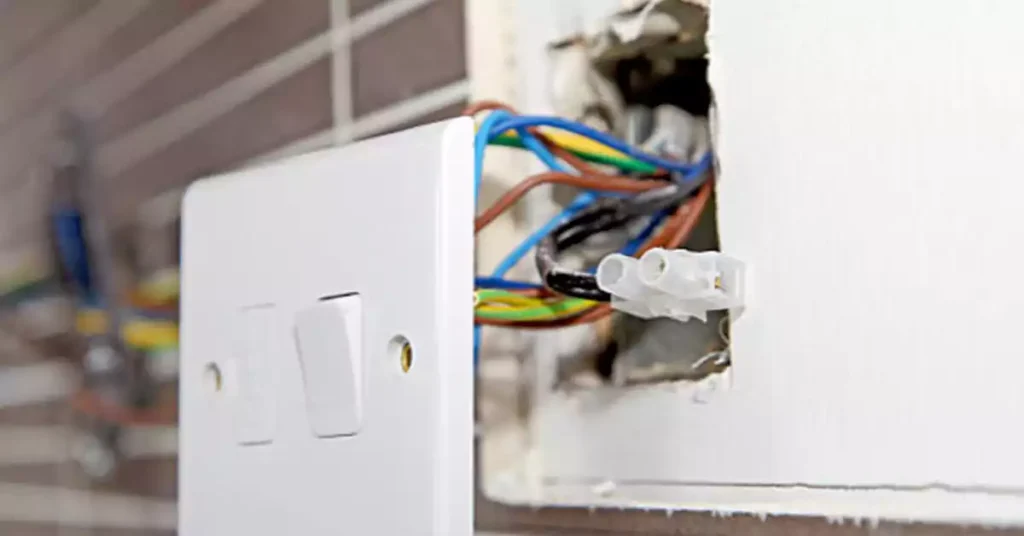
Complying with AS/NZS 3000:2018 (Wiring Rules) is not just a regulatory requirement—it’s a critical part of ensuring safety, reliability, and long-term performance in electrical installations across Australia and New Zealand. Whether you’re a licensed electrician, electrical engineer, contractor, or inspector, understanding the steps to compliance helps prevent costly rework, avoid hazards, and deliver installations that meet modern standards.
Step 1: Understand the Project Scope and Requirements
Before any physical work begins, clearly define the type of installation and the intended application. Determine if it’s a:
New residential build
Commercial renovation
Industrial upgrade
EV charging installation
Solar or battery energy system
Hazardous location (Zone classification required)
Step 2: Design the Electrical Installation
The design phase must reflect both compliance and practicality. Use AS/NZS 3000 guidelines to:
Determine wiring methods (e.g., conduit, cable tray, TPS cabling)
Select protective devices (e.g., circuit breakers, RCDs, surge protection)
Size conductors and cables based on current-carrying capacity, voltage drop, and installation conditions
Choose appropriate earthing arrangements and bonding as per Section 5
Plan for fire safety and mechanical protection of wiring
Step 3: Select Compliant Materials and Components
Ensure that all materials meet Australian/New Zealand standards. For conduits, switches, circuit breakers, cables, boxes, and connectors:
Use AS/NZS certified products (e.g., AS/NZS 2053 for conduits, AS/NZS 3191 for flexible cords)
Confirm environmental suitability (UV resistance, halogen-free, IP rating, etc.)
Use electrically and mechanically rated components for intended applications
Choose fire-resistant products where required (especially in ceiling spaces or fire-rated walls)
Step 4: Install According to AS/NZS 3000 Guidelines
Carry out the installation as per the design and the Wiring Rules:
Secure wiring and conduits properly with clips, saddles, and boxes
Avoid damage to insulation, bending cables too tightly, or overcrowding conduits
Maintain minimum clearances from heat sources, water pipes, or flammable materials
Install safety switches (RCDs) as required by Section 2 for all final sub-circuits supplying socket-outlets, lighting, or fixed appliances
Follow the zone rules for bathrooms and wet areas (Section 6.2)
Tip: Photographic documentation during installation can assist with future inspection and fault finding.
Step 5: Perform Testing and Verification
Once installation is complete, testing and verification ensure compliance and safety. According to Section 8 – Verification, test for:
Continuity of conductors
Insulation resistance
Earth fault loop impedance
Polarity
Correct circuit protection
Step 6: Record and Certify the Installation
In most jurisdictions, electricians must provide a Certificate of Compliance (COC) upon completion. Ensure all documentation is clear, accurate, and includes:
Circuit layout and schedules
Test results
Equipment datasheets
Product certifications and markings
Risk assessments for special installations
Tip: Some states or regions may also require lodgment through regulatory portals.
Step 7: Ongoing Maintenance and Compliance
AS/NZS 3000 also emphasizes maintainability. Especially in commercial, industrial, or public spaces:
Install systems to allow future inspection, access, and servicing
Document changes or upgrades for future compliance assessments
Ensure any alteration or extension complies with current rules (not just the original installation date)
5 Common AS/NZS 3000 Violations
Despite the comprehensive guidance of the AS/NZS 3000:2018 Wiring Rules, many installations in Australia and New Zealand still fall short of compliance due to overlooked details, misinterpretation of clauses, or poor workmanship. Identifying common violations not only helps improve safety and reliability but also saves time and cost during inspection or certification.
Below are some of the most frequent AS/NZS 3000 non-compliance issues—and how to avoid them.
Improper RCD Protection
The Violation:
RCDs (Residual Current Devices) not installed where required, or incorrect types used (e.g., Type AC instead of Type A or B for EV chargers and appliances with electronic controls).
How to Avoid It:
Install RCDs on all final sub-circuits supplying socket-outlets, lighting, and fixed appliances in domestic and commercial installations.
For EV chargers or equipment with electronic loads, always use Type A or Type B RCDs as specified in the standard.
Regularly test RCD operation and label appropriately.
Inadequate Cable Support or Mechanical Protection
The Violation:
Cables installed without proper fixing, unsupported in ceiling spaces, or exposed to mechanical damage without conduit protection.
How to Avoid It:
Follow the standard which requires cables to be securely supported at regular intervals.
Use AS/NZS 2053 or AS/NZS 61386 compliant conduits for mechanical protection in exposed or underground locations.
In roof spaces or wall cavities, install cable trays or saddles to prevent sagging or contact with sharp surfaces.
Incorrect Earthing and Bonding
The Violation:
Improper connection of protective earthing conductors, missing bonding to metallic pipework or structures, or use of incorrect conductor sizes.
How to Avoid It:
Comply with Section 5.5 and 5.6, ensuring all exposed conductive parts are earthed.
Use conductors of the correct size and material as per Table 5.1.
Bond all extraneous conductive parts (e.g., water pipes, structural steel) in accordance with Clause 5.6.2.5.
Voltage Drop Exceeding Limits
Long cable runs result in voltage drops beyond the acceptable range, causing poor performance of appliances and potential overheating.
How to Avoid It:
Calculate voltage drop for all final subcircuits using Clause 3.6.2.2, ensuring it stays within the recommended 5% limit.
Use larger cable sizes for long runs or high-load circuits such as EV chargers or HVAC units.
Undersized or Incorrect Conduits
Using undersized conduits that do not allow for cable movement or future upgrades, or using non-compliant conduit materials.
How to Avoid It:
Select conduit size based on Clause 3.10, allowing for at least 40% spare capacity.
Use AS/NZS 2053-compliant PVC rigid or corrugated conduit and fittings, or AS/NZS 61386 series for performance-classified systems (e.g., HD or VHD).
Use UV-resistant and impact-resistant conduit for external installations (marked with “T” for UV and “HD” or “VHD” for mechanical protection).
What’s New in the 2023 Version of AS/NZS 3000
The 2023 update to AS/NZS 3000:2018, commonly referred to as the Wiring Rules, reflects the evolving landscape of electrical safety and technology in Australia and New Zealand. This revision includes more than 200 changes, aimed at enhancing clarity, improving safety, and accommodating emerging technologies such as electric vehicles (EVs), solar PV systems, and smart electrical infrastructure.
Key Changes in AS/NZS 3000:2023
Here are some of the notable updates in the 2023 version:
1. Clarified RCD Requirements
The rules around Residual Current Devices (RCDs) have been clarified and expanded:
RCD protection is now mandatory for all final subcircuits in residential installations, including alterations and repairs.
Greater detail is provided for RCD protection on socket outlets and lighting circuits.
2. Revised Cable Installation Through Insulation
Updated guidance is provided for installing cables through thermal bulk insulation, with emphasis on avoiding overheating and ensuring long-term safety compliance. The standard introduces new allowances and protective measures depending on cable type and usage environment.
3. Bathroom and Laundry Exclusion Zones
The standard now includes updated exclusion zones for socket outlets and light switches in wet areas such as:
Bathrooms
Laundries
These changes ensure reduced risk of electric shock in areas exposed to moisture.
4. Cooktops and Hot Water System Controls
New switching requirements are introduced for:
Electric cooktops, which now require accessible isolation switches.
Hot water heaters, with updated requirements for disconnection and control.
Additionally, exclusion zones for outlets and switches near cooktops are now more clearly defined to minimize fire risk.
5. Enhanced Earthing Reaquirements
The 2023 revision strengthens the requirements for:
General earthing systems
Swimming pool earthing (where potential equalization is critical to safety)
Verification processes related to earthing continuity
6. Switchboard and Clearance Enhancements
To support safer and more accessible installations, the update includes:
Clear minimum clearance requirements for switchboards
Enhanced installation practices for residential and commercial applications
7. Renewable Energy and Distributed Generation
The revised standard incorporates modern generation systems, including:
Rooftop solar photovoltaic (PV) systems
Other distributed energy resources (DERs)
8. New EV Charging Provisions
For the first time, the standard explicitly addresses electric vehicle (EV) charging infrastructure, including:
Dedicated EV socket outlets
Load control considerations
Isolation switch requirements
This aligns with the growing adoption of EVs and ensures that infrastructure is future-ready and safe.
AS/NZS 3000 vs. Other Electrical Codes (NEC and CEC)
The AS/NZS 3000:2018 Wiring Rules (commonly known as the Australian/New Zealand Wiring Rules) set out the essential safety requirements for electrical installations in Australia and New Zealand. While it shares a similar safety philosophy with other major codes such as the U.S. National Electrical Code (NEC) and Canada’s Canadian Electrical Code (CEC), there are important differences in structure, terminology, technical detail, and regional adaptation.
Code Structure and Jurisdiction
AS/NZS 3000: Jointly developed by Australia and New Zealand, and legally mandated or referenced in national/state regulations. The standard integrates safety, design, and installation best practices tailored to local conditions
NEC (NFPA 70): Published by the National Fire Protection Association (NFPA) and adopted across the U.S., the NEC is updated every three years and focuses heavily on fire prevention and electrical safety.
CEC (CSA C22.1): Published by the Canadian Standards Association, the CEC is used across Canadian provinces with province-specific amendments.
Voltage Systems and Earthing
AS/NZS 3000: Commonly uses the TN-C-S (MEN) earthing system, which is mandatory in residential and many commercial settings. Protective Earth (PE) and Neutral (N) are bonded at the main switchboard.
NEC and CEC: Allow various grounding systems, including TN, TT, and IT, with detailed requirements for grounding electrode conductors, bonding, and neutral-ground separation.
RCD (Residual Current Device) Requirements
AS/NZS 3000: RCDs are mandatory for nearly all final subcircuits in residential and many commercial installations. Recent changes require Type B RCDs for EV chargers.
NEC: Requires GFCI (Ground-Fault Circuit Interrupter) protection for specific areas like bathrooms, kitchens, outdoors, and EV outlets, but the rules are more selective than AS/NZS 3000.
CEC: Similar to NEC, but includes Canadian-specific additions; RCDs are known as GFCIs or Class A devices, and EV requirements also depend on charger type.
Cable Installation and Insulation
AS/NZS 3000: Emphasizes cable de-rating in bulk insulation, defines exclusion zones, and mandates physical protection. Uses AS/NZS-specific cable types.
NEC/CEC: Offer extensive tables for conductor ampacities, temperature corrections, and bundling adjustments. Use North American wire types (e.g., NM, THHN).
EV Charging Provisions
AS/NZS 3000: Includes Clause 7.9 dedicated to electric vehicle charging (NZ only), outlining Mode 2 to Mode 4 installations, RCD protection, cable ratings, and installation heights.
NEC (Article 625): Defines EVSE requirements, including dedicated branch circuits, overcurrent protection, GFCIs, and labeling.
CEC: Incorporates EV charger requirements similar to NEC with added provincial guidance; both Level 1 and Level 2 charging are addressed.
Gefahrenbereiche
AS/NZS 3000 follows the IEC Zone system and refers to the AS/NZS 60079 series for detailed classification, equipment selection, and installation. These rules ensure safe operation in areas with potential explosion risks.
NEC uses a Class and Division system, although the Zone system is also permitted. It defines hazards based on the likelihood and type of explosive materials.
KEK mainly adopts the IEC Zone system, similar to AS/NZS 3000, and references the same IEC 60079 standards for hazardous locations.
AS/NZS 3000 Vs. NEC Vs. CEC Comparing Chart
Aspekt | AS/NZS 3000:2018 | NEC (NFPA 70) | CEC (CSA C22.1) |
Code Structure & Jurisdiction | Jointly developed by Standards Australia & Standards NZ; legally mandated or referenced in federal/state regs; integrates safety, design & installation best practices for local conditions. | Published by NFPA; adopted nationwide in the U.S.; updated triennially; heavy emphasis on fire prevention & general electrical safety. | Published by CSA; adopted by provinces with province-specific amendments; aligns with North American practices while accommodating local climates and loads. |
Voltage Systems & Earthing | Mandates TN-C-S (MEN) system in residential/commercial; PE and N bonded at main switchboard; detailed earthing conductor sizing. | Allows TN, TT, IT systems; specifies grounding electrode conductor sizing, bonding, and neutral-ground separation rules. | Similar to NEC’s flexibility (TN, TT, IT), but includes Canadian soil resistivity considerations and additional bonding requirements. |
RCD/GFCI Requirements | RCDs mandatory on nearly all final sub-circuits in homes & many commercial installs; Type B RCDs now required for EV chargers. | GFCI required in specified locations (bathrooms, kitchens, outdoors, garages, damp areas, EV outlets) but more selective overall. | “GFCI” or Class A devices required in NEC-style locations plus cold-climate adaptations; EV outlet protection depends on charger class. |
Cable Installation & Insulation | Emphasises cable de-rating for thermal grouping, exclusion zones near heat sources, mandatory mechanical protection; uses AS/NZS-specified cable types. | Extensive ampacity tables, temperature correction & bundling adjustment factors; uses North American cable types (e.g. NM, THHN). | Mirrors NEC tables but adds derating for long runs in cold climates; Canadian-approved cable types with CSA markings. |
EV Charging Provisions | Clause 7.9 (NZ only) covers Modes 2–4, RCD protection, cable ratings & mounting heights; residential & public station guidance. | Article 625: dedicated branch circuits, overcurrent & GFCI protection, signage & working-clearance rules. | Incorporates Article 625 requirements plus provincial annexes; addresses Level 1 (120 V) & Level 2 (240 V) charging with local amendments. |
Gefahrenbereiche | Follows IEC Zone system; references AS/NZS 60079 series for gas/dust classification, equipment selection & installation. | Uses Class/Division method by default (Zones permitted); defines hazards by material type & likelihood; NFPA 496 for classification. | Adopts IEC Zone system (like AS/NZS 3000); references IEC 60079 and CSA Group guidance; includes Canadian explosive-atmosphere tables. |
Practical Applications
Understanding AS/NZS 3000:2018 isn’t just about compliance—it’s about applying the Wiring Rules effectively in real-world projects. For electrical contractors and manufacturers, these applications ensure safer installations, reduce risk, and help maintain a high standard of workmanship across the industry. Here’s how the standard plays out in practice:
For Electrical Contractors
Designing and Installing Compliant Systems
Contractors must reference AS/NZS 3000 from the design stage onward to:
Ensure correct cable sizing, circuit protection, and earthing.
Meet RCD protection requirements, especially after the 2023 updates.
Follow installation methods for wiring systems in varying environments (e.g. damp locations, roof spaces, or areas with insulation).
Working with Emerging Technologies
The standard supports safe integration of new technologies, such as:
Electric Vehicle (EV) charging systems – following Section 7.9 (NZ only).
Solar and battery storage systems – ensuring isolation, fault protection, and system compatibility.
Smart home automation – where clear wiring practices and compliance with safety distances are critical.
Verifying and Certifying Installations
Post-installation, contractors must:
Conduct thorough testing and verification in line with Section 8.
Document results and keep inspection records, especially for high-risk or commercial projects.
Identify and resolve non-compliances to avoid violations.
For Manufacturers
Product Design Aligned to Standards
Electrical product manufacturers—such as those producing conduit, wiring accessories, switchboards, and EV chargers—must:
Design equipment that meets dimensional and performance standards.
Provide products compliant with IP ratings, RCD types (e.g., Type B for EV chargers), and flammability classifications where needed.
Clear Product Marking and Documentation
AS/NZS 3000 and referenced standards (e.g. AS/NZS 3100, AS/NZS 60079) require:
Legible markings for voltage, current ratings, approval numbers.
Installation guides that help contractors follow best practices.
Product compliance to AS/NZS certifications, proving safety for use in Australia and New Zealand.
Support for Installation Environments
Manufacturers must ensure that products are fit for:
Outdoor or underground use (e.g. UV-resistant conduits, IP-rated enclosures).
Hazardous areas, where compliance with AS/NZS 60079 is essential.
Residential and commercial builds, including locations like bathrooms, rooftops, and data centers.
Ledes Products Support for AS/NZS Compliance
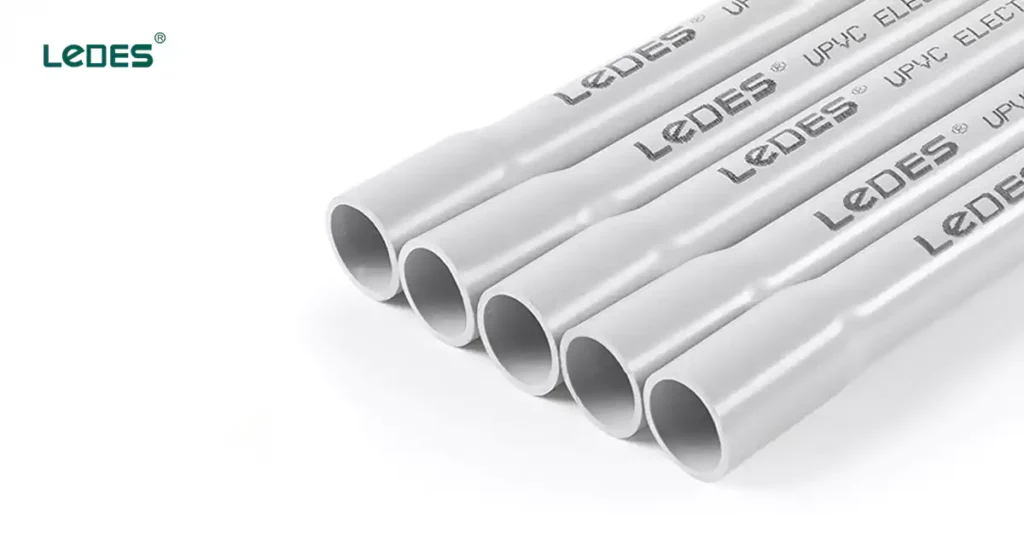
As the AS/NZS 3000:2018 Wiring Rules continue to guide safe and reliable electrical installations across Australia and New Zealand, selecting compliant conduit systems becomes essential for both electrical contractors and project developers. Ledes understands these evolving compliance needs and offers a full range of AS/NZS-certified conduit solutions designed to help meet the standard’s strict safety, mechanical, and environmental requirements.
AS/NZS 3000 emphasizes mechanical protection, UV resistance, flame retardancy, and durability in harsh environments. To help meet these performance benchmarks, Ledes manufactures a wide variety of conduit products that align with key sections of the standard — including provisions for wiring protection in damp locations, underground systems, commercial installations, and communication pathways.
AS/NZS - Compliant Conduit Offerings
Starre Leitung
Ledes rigid conduits are built for tough environments where strength and structural integrity are critical. Compliant with AS/NZS 2053.2 and AS/NZS 2053.1, these conduits are:
- UV-resistant, ideal for outdoor installations.
- Designed to provide mechanical impact protection in both surface-mounted and buried systems.
- Available in a range of sizes and both medium-duty and heavy-duty ratings to suit residential, commercial, and industrial settings.
Wellrohr
Flexible yet robust, Ledes corrugated conduit is designed to handle installations where routing through tight or uneven spaces is required. Compliant with AS/NZS 2053.5 and 2053.16, this conduit is:
- Available in both medium-duty and heavy-duty variants.
- Engineered for flexibility, crush resistance, and ease of handling.
- Suitable for indoor use, underfloor cabling, and enclosed wall systems where flexibility and compliance with flame and UV requirements are key.
Communication Conduits
AS/NZS 3000 requires appropriate segregation and protection of communication wiring. Ledes provides communication conduit systems in accordance with AS/NZS 2053.1 and AS/NZS 2053.2 and AS/NZS 2053.5, ideal for protecting data and low-voltage communication cables in both commercial and residential installations.
Leitungsverschraubungen
For a complete and compliant installation, Ledes offers a full range of matching Leitungsverschraubungen, including elbows, couplings, adapters, tees, junction boxes, and clips. These fittings are:
- Manufactured to match the mechanical and fire resistance requirements of Ledes conduits.
- Designed for compatibility with both medium-duty and heavy-duty systems.
- Built with UV-stabilized materials for outdoor durability.
Ledes is committed to helping contractors and engineers build safer, code-compliant electrical systems. By offering a comprehensive selection of rigid and corrugated conduits, communication conduits, and fully compatible fittings, all designed to meet AS/NZS 3000 and related conduit standards. Ledes makes it easier to specify, install, and inspect compliant electrical conduit systems in Australia and New Zealand.
Abschluss
The AS/NZS 3000:2018 Wiring Rules remain the cornerstone of safe, reliable, and efficient electrical installations across Australia and New Zealand. From general wiring principles and protection requirements to provisions for hazardous areas and the integration of communication systems, this standard provides a unified framework that ensures consistency and safety in a wide range of applications — residential, commercial, and industrial alike.
As we move toward 2025 and beyond, the relevance of AS/NZS 3000 continues to grow, especially with the increasing demand for solar energy systems, electric vehicles, smart infrastructure, and communication integration. For electrical professionals, keeping up with the standard’s technical and legal requirements is not only a matter of compliance but a commitment to public and operational safety.
Ultimately, AS/NZS 3000 is more than just a rulebook, it’s a foundation for building the electrical systems of the future. Whether you’re an installer, designer, inspector, or manufacturer, staying informed and choosing compliant solutions is essential to driving safe innovation in electrical infrastructure.
FAQs
Was ist der AS/NZS 3000-Standard für Verdrahtungsregeln?
AS/NZS 3000, allgemein bekannt als „Verdrahtungsregeln“, ist eine gemeinsame australisch-neuseeländische Norm, die die Mindestanforderungen für die Planung, den Bau und die Prüfung elektrischer Anlagen festlegt. Sie umfasst Sicherheitsprinzipien, Geräteauswahl, Installationspraktiken und spezifische Anwendungen wie Gefahrenbereiche und Ladesysteme für Elektrofahrzeuge.
Ist die Einhaltung von AS/NZS 3000 obligatorisch?
Ja. Die Einhaltung der AS/NZS 3000 ist für elektrische Anlagen in Australien und Neuseeland gesetzlich vorgeschrieben. Die Norm wird in der Regel in den Vorschriften zur elektrischen Sicherheit erwähnt, sodass ihre Einhaltung Voraussetzung für die Erlangung von Genehmigungen und Zertifizierungen ist.
Was ist die neueste Version von AS/NZS 3000?
Die aktuellste Version ist AS/NZS 3000:2018, die Änderungen bis Änderung 3 (2023) enthält. Ab 2025 bleibt diese Version gültig, sofern sie nicht durch eine neuere Ausgabe ersetzt wird. Nutzer sollten sich stets bei Standards Australia oder den neuseeländischen Aufsichtsbehörden über die neuesten Aktualisierungen informieren.
Enthält AS/NZS 3000 Bestimmungen für Ladesysteme für Elektrofahrzeuge (EV)?
Ja. Abschnitt 7.9 der AS/NZS 3000:2018 (nur Neuseeland) enthält detaillierte Anforderungen für Ladesysteme für Elektrofahrzeuge im privaten und gewerblichen Bereich. Er umfasst die Stromkreisdimensionierung, den FI-Schutz (Typ B), die Steckdosentypen und die Installationsorte für das Laden im Modus 2, 3 und 4. Diese Bestimmungen gewährleisten die sichere Integration der Elektrofahrzeug-Infrastruktur in elektrische Anlagen.
Welche Leistungsklassifizierungen gelten für Leitungen in den AS/NZS-Normen?
Conduits under the AS/NZS 2053 and AS/NZS 61386 series are classified by duty ratings, which indicate their mechanical performance:
VLD – Very Light Duty
LD – Light Duty
MD – Medium Duty
HD – Heavy Duty
VHD – Very Heavy Duty
These classifications reflect resistance to compression, impact, and temperature.
Was ist der Unterschied zwischen mittelschweren und schweren Leitungen?
The duty rating refers to a conduit’s ability to withstand mechanical stress.
Medium-duty (MD) conduit is suitable for standard domestic or light commercial use where moderate protection is required.
Heavy-duty (HD) conduit is recommended for harsher environments, such as industrial sites or locations with frequent physical impact or exposure.
Gilt AS/NZS 3000 für Photovoltaikanlagen?
Ja. AS/NZS 3000 enthält allgemeine Anforderungen an Solaranlagen, insbesondere hinsichtlich Isolierung, Überstromschutz und Verdrahtungspraktiken. Es muss jedoch zusammen mit AS/NZS 5033 (Installations- und Sicherheitsanforderungen für Photovoltaikanlagen) verwendet werden, das spezifische Konstruktionsregeln für PV-Systeme enthält.
Sind RCDs in allen Stromkreisen erforderlich?
Ja, gemäß der Revision von AS/NZS 3000 aus dem Jahr 2023 ist ein RCD-Schutz für fast alle Endstromkreise in Wohngebäuden – einschließlich Beleuchtung und Steckdosen – sowie für ausgewählte gewerbliche und industrielle Stromkreise vorgeschrieben. Es gibt zwar spezifische Ausnahmen (z. B. für bestimmte Notsysteme), aber die breite Anwendung ist mittlerweile Standard.
Was ist das in AS/NZS 3000 erwähnte MEN-System?
MEN steht für Multiple Earthed Neutral. Es handelt sich um das Standard-Erdungssystem in Australien und Neuseeland, bei dem der Neutralleiter an mehreren Punkten geerdet wird, einschließlich der Hauptschalttafel einer Anlage. Dies gewährleistet einen effektiven Fehlerschutz und ist ein wesentlicher Bestandteil des nach AS/NZS 3000 geforderten elektrischen Sicherheitssystems.
Welche Rolle spielt AS/NZS 2053 im Verhältnis zu AS/NZS 3000?
AS/NZS 2053 ist eine Referenznorm innerhalb von AS/NZS 3000 und definiert Anforderungen an elektrische Leitungssysteme und Armaturen, einschließlich Materialien, Belastbarkeit, mechanischer Festigkeit und Kennzeichnung. Produkte, die AS/NZS 2053 entsprechen, helfen Installateuren, die in AS/NZS 3000 festgelegten Anforderungen an physischen Schutz und Kabelunterstützung zu erfüllen.
Wie wird der Spannungsabfall in AS/NZS 3000 behandelt?
Die Norm schreibt vor, dass der Spannungsabfall zwischen dem Versorgungspunkt und den Geräten 5% der Nennspannung nicht überschreiten darf. Um die ordnungsgemäße Funktion der elektrischen Geräte zu gewährleisten, müssen Konstrukteure den Spannungsabfall anhand der Leitungslänge, des Laststroms und der Leitergröße berechnen.
Verweise


